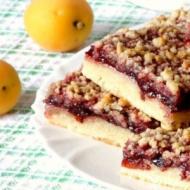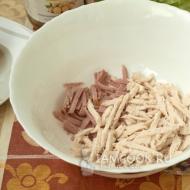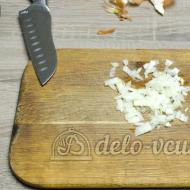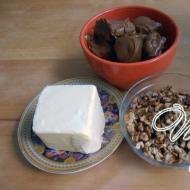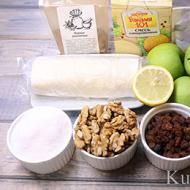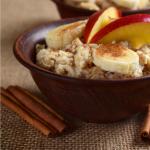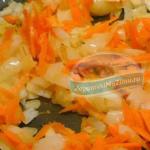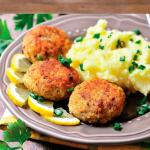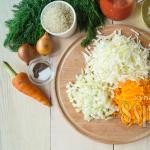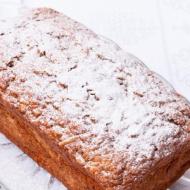
Italian cooking recipes. What to try in Italy: traditional cuisine and food. National dish of Italy: Roman artichokes
Those who have had the opportunity to try dishes of national Italian cuisine in its homeland: in Rome, Naples, Bologna and other cities will confirm: this is a completely special story.
The characteristic features of Italian cuisine are explained by the local climate and those products that have become widespread in a particular region. Each region of Italy boasts special recipes. This makes exploring Italian food doubly exciting. Meet 10 national dishes of Italy that tourists must try.
Minestrone
Contrary to popular belief, Italian cuisine is far from limited to foods such as pizza or spaghetti. Soups that are very popular in Italy are: burrida (with seafood), ginestrata (with egg yolks and white wine), minestra di noci (with walnuts and nut puree) and others. But first of all, you should try minestrone - a traditional vegetable soup that has become the embodiment of the characteristics of national Italian cuisine.

Initially, in Italy, minestrone was prepared from leftover main courses or cheap vegetables. And although today there is no trace of such an approach to food in the national cuisine, as in many other Italian recipes, it assumes the ability to “mix everything that is available” so that it turns out divinely tasty.
The main components of minestrone are meat broth and fresh vegetables, which can be as much as you like depending on the season. Therefore, the consistency of the dish varies from liquid to incredibly thick. In some national recipes of Italian cuisine, minestrone is complemented with rice, pasta, and pesto sauce. Before eating the soup, add grated Parmesan and fresh chopped herbs to the bowls.
Carpaccio
It is impossible to imagine a list of food things to try in Italy without carpaccio - thinly sliced meat or fish, seasoned with sauce with the addition of mayonnaise, olive oil, vinegar, and lemon juice.

Although the recipe for this dish appeared relatively recently in Italy, today it is included in the menu of all restaurants of national cuisine. To prepare it, most often you take raw beef tenderloin, previously placed in the freezer. In Italy, you can also try variations of the dish in which beef is replaced with venison, tuna, salmon, sea bass, octopus or smoked duck.
According to the traditions of Italian cuisine, before serving, carpaccio is sprinkled with thin shavings of cheese and decorated with fresh herbs. It's interesting to try carpaccio with... For example, sommeliers recommend rich red wines for venison, and rose wine from the south of Italy for tuna.
Tortellini
The list of national dishes of Italy continues with tortellini - a type of pasta that in appearance is close to such familiar food as dumplings.

In Italy, tortellini is prepared from unleavened unsalted dough and served as a separate dish (with aromatic mushroom, creamy or Bolognese sauce) or added to broths, soups and salads. The most common fillings for tortellini are meat, ham or cheese. The result is a very satisfying and tasty meal.
Don't miss the opportunity to try other variations of this traditional Italian dish. For example, tortelletti (they are much smaller in size) and tortelli (these, on the contrary, are larger). To give the dough an original color, spinach or tomatoes are sometimes added to it: in the first case, the tortellini will be green, and in the second, red.
Gnocchi
Gnocchi is a fairly simple Italian food, which, nevertheless, is considered one of the most worthy examples of national local cuisine. This dish is a type of dumpling, for the preparation of which cooks take flour, eggs, semolina or corn grits and potatoes.

Small pieces formed from dough are given an oval shape, and then dipped in boiling salted water and boiled with seasonings. Serve as a side dish, but it is better to try gnocchi as a separate dish, with a thick, aromatic sauce. Gnocchi with fish and seafood (shrimp, salmon, crab, sea bass, vongole) is especially popular - it’s a real masterpiece of taste!
There are also many original variations of this national Italian dish. For example, in other cities in Italy you can try gnocchi with lemon ricotta or gorgonzola, pumpkin gnocchi with bacon and savoy cabbage in cream, and even gnocchi with chestnuts - such traditional Italian cuisine will definitely not leave you indifferent.
Risotto
If you want to try the best Italian dishes, do not ignore risotto - a food that has become one of the culinary symbols of the country. The basis for its preparation is short-grain rice of special varieties, which is first fried and then stewed. When the dish is almost ready, seafood, minced meat, vegetables or mushrooms are added to it - depending on what the chef wants to get in the end.

Many restaurants and cafes in Italy offer menus with different, sometimes very unexpected, types of risotto: eggplant, shrimp, bacon and apple, berries and onions, white truffles, cheese and green asparagus, and even cuttlefish ink. In a word, this is a national dish that you definitely need to try while traveling in Italy.
Pizza
It is impossible to imagine traditional Italian dishes without pizza. They simply adore this food here, which is why you can literally see a sign for one or another pizzeria at every step. There are Italian eateries where the menu consists entirely of different types of pizza. And in some establishments you can even see with your own eyes the process of its preparation in the kitchen.

According to tradition, the pizza dough is left to “ripen” for almost a day (about 18 hours). Only the freshest products are selected for the filling. The pizza is cooked in a wood-fired oven, which preserves the taste and aroma of all the ingredients, and the dish itself turns out divine - you can try it and see for yourself!
Lasagne
Lasagna is one of the most popular and famous Italian dishes that all tourists strive to try. It is a multi-layer casserole in which sheets of dough are alternated with a filling of minced meat, mushrooms or vegetables and generously flavored with a thick, aromatic sauce. An obligatory ingredient of the dish is cheese: ricotta, Parmesan, Gorgonzola or mozzarella.

Lasagna is something that is worth trying in Italy: in no other kitchen in the world is it prepared so inventively and fantastically tasty. In addition to the classic version with meat, in many establishments you can also order vegetarian lasagna - it tastes just as good as its meat counterpart.
Trippa
Those who want to try the best and most popular dishes of Italian cuisine will have to take a chance and order food with a very specific name. Which one? Of course, trippa!

Trippa is prepared from tripe, beef tripe - in other words, from the front part of a cow's stomach, which is pre-soaked, washed and cut into pieces. Then it is boiled, fried and stewed with wine, vegetable or meat sauce, seasoned with salt and pepper. Serve with grated cheese, sometimes adding mint.
Initially in Italy this food was a dish of the poor. This state of affairs continued almost until the middle of the 20th century. Today trippa is considered a delicacy and is on the menu of many restaurants serving national Italian cuisine.
They say that trippa is one of those traditional Italian dishes that are not very suitable for the “unusual” stomach of a tourist. However, thanks to long-term heat treatment, the food turns out to be quite tender, light and incredibly tasty.
Gelato
Gelato is a national Italian delicacy made from milk, cream and sugar. It contains nuts, fresh fruits and berries, fruit sauce, coffee, cocoa and chocolate, candied fruits, honey, caramel, and liqueur. All over the world, such food is considered a type of ice cream, but differs from it in lower milk fat content and production technology.

For real gelato, only natural ingredients are used. The dessert may contain emulsifiers and stabilizers, but in minimal quantities. In general, gelato is prepared in special pastry shops - gelaterias, where the master creates each dessert by hand and serves it immediately after preparation.
The best gelaterias in Italy offer you to try their exclusive versions of this national delicacy. For example, San Crispino in Rome uses Rhum Clement whiskey and chocolate, Clement rum and cocoa for its desserts. And this example is just one of the many subtleties that make gelato the pinnacle of the national Italian art of creating delicious desserts.
Tiramisu
Tiramisu hardly needs any introduction. To prepare this traditional Italian dessert, you need very few ingredients: savoiardi cookies, mascarpone cheese, freshly brewed coffee, eggs and sugar, as well as cocoa or chocolate chips for sprinkling.

Over the many years of existence of the recipe, various variations have appeared in the collection of national Italian cuisine. You can try tiramisu with the addition of strawberries and other berries, liqueur or cognac. The most delicate, refined taste of this dessert remains unchanged, which will captivate you once and for all.
What else to eat in Italy
Italy will take you on a real gastronomic adventure. Cooking in this country is even more than art - it is a way of life, a national worldview.
How can you have time to try everything? Below you will find a small hint of what else you can eat in Italy:
- (Parma ham);
- Artichokes (boiled, fried, grilled);
- Panini (closed hot sandwich with filling);
- Ravioli (dumplings with various fillings);
- (with meat, seafood, vegetables);
- Caprese (fresh tomato and mozzarella salad);
- Panna Cotta (dessert made with cream, sugar and vanilla);
- Frittata (baked omelette with vegetables and cheese).
Guys, we put our soul into the site. Thank you for that
that you are discovering this beauty. Thanks for the inspiration and goosebumps.
Join us on Facebook And In contact with
Pasta and pizza are two of the most popular dishes around the world that sunny Italy gave us. In fact, the range of traditional dishes of this distinctive country is so rich and varied that it is difficult to fit it into one article.
However, the editors website I have chosen for you the 10 most famous and most delicious Italian dishes that you will definitely want to try.
Panini
A traditional Italian hot sandwich filled with ham, Parmesan, tomatoes and pesto sauce on wheat bread, it has become popular all over the world for its simple yet sophisticated taste.
You will need (for 4 servings):
- 8 slices white bread
- 2 tbsp. l. butter
- 200 g Mozzarella
- 2 tomatoes
- 2 tbsp. l. pesto sauce
- fresh basil leaves to taste
Preparation:
- Spread pesto on 4 slices of bread.
- Cut the mozzarella and tomatoes into thin slices. Place tomato slices on halves of bread with pesto and top with Mozzarella.
- Then, if desired, you can put basil leaves on top, and cover each sandwich with the other half of the bread.
- Then heat the pan and fry the panini in butter for 3 minutes on each side.
Panna cotta
A real celebration of taste made from cream, sugar and vanilla. The name of this amazing dessert is translated from Italian as “boiled cream” and is prepared mainly in the north of the country.
You will need:
- 1 liter full fat unsweetened pastry cream
- 150 g grated raspberries (optional)
- 20 g gelatin
- 20 whole raspberries (optional)
- 2-3 tbsp. l. Sahara
- 1/2 tsp. vanillin
Preparation:
- Pour the cream into a small saucepan, place over low heat, add sugar and vanilla.
- Dilute the gelatin with a small amount of warm water, then pour it into the heated cream, mix everything well until smooth - the gelatin should dissolve. Pour dessert into bowls.
- Place raspberries in each glass with buttercream.
- Refrigerate the dessert for at least 4 hours, during which time it should harden well.
- Pour grated raspberries (or any other berry sauce) over the dessert and serve.
Chicken Parmignana
One of the most popular dishes in the Campania region and Sicily has become widespread in the United States. Tender chicken fillet baked in tomato sauce with Parmesan is the perfect complement to spaghetti.
You will need:
- black pepper - 1/2 tsp.
- breadcrumbs - 2/3 cup
- salt - 1 tsp.
- red hot pepper - 1/2 pod
- Parmesan cheese - 50 g
- chicken (breast) - 1 pc.
- sifted flour - 1/2 cup
- basil - 1 bunch
- olive oil - 3-4 tbsp. l.
- Mozzarella cheese - 4 slices
- large egg - 1 pc.
- young garlic - 4 cloves
- large tomatoes - 3-4 pcs.
- small onion - 1-2 pcs.
Preparation:
- Remove skin and bones from the chicken breast, wash and dry with a towel. Cut each half lengthwise into 2 parts. Season with salt, black pepper, chopped garlic and basil. Add 1-2 tablespoons of olive oil, stir and refrigerate for 1 hour.
- Prepare the sauce. To do this, fry an onion cut into small cubes until transparent in 2 tablespoons of olive oil, add chopped garlic, simmer for another 5 minutes. Then add grated or blended tomatoes and hot pepper flakes. Simmer for 10-15 minutes to evaporate excess liquid. Add chopped basil to the prepared sauce.
- Prepare 3 containers for breading. Pour flour into the first, break a raw egg mixed with a little water into the second, and place a mixture of breadcrumbs and Parmesan cheese, grated on a fine grater, into the third. Roll each piece of chicken fillet successively in flour, lezone and bread-cheese mixture and place on a greased baking sheet or in a baking dish. Place in preheated oven for 15 minutes.
- Remove the pan with the fillets from the oven and top each piece with a layer of tomato sauce and a slice of Mozzarella cheese. Return the pan with the fillets to the oven and bake for another 5 minutes. Serve garnished with a sprig of fresh basil.
Gelato
The taste of the original Italian dessert gelato cannot be compared with any other ice cream. It is rightfully considered the best sweet culinary masterpiece of this sunny country.
You will need:
- 250 ml whole milk
- 250 ml cream with a fat content of 33-35%
- 4 egg yolks
- 150 g sugar
- 1 vanilla pod or 1 tsp. vanilla extract
Preparation:
- Pour milk into a deep non-stick bowl, add cream and half a portion of sugar. Heat over low heat and bring the mixture until small bubbles appear, stirring constantly. Don't boil! Remove from heat, add vanilla extract.
- Separate the yolks from the whites. Lightly beat the yolks. You can beat it either manually (with a whisk) or using a mixer.
- Add the second part of sugar and continue whisking continuously. Pour in a little more hot mixture and continue whisking for another 1-2 minutes. Pour the yolk-sugar mixture into the milk-cream mixture and continue whisking continuously. Heat the mixture over low heat, stirring constantly.
- Using a thermometer, measure the temperature of the mixture. It is very important to prevent it from overheating. The custard is ready when it begins to thicken and reaches 185°F (85°C). You can determine the temperature without a thermometer by observing the cooking process. As soon as the mixture begins to bubble, the heating process must be completed. The custard is completely ready when it has become sufficiently thick and viscous. Just enough to completely cover the back of the spoon or spatula.
- Strain the mixture through a sieve to avoid lumps into a deep bowl immersed in crushed ice. The ice bath will allow the hot custard to cool much faster so it can be cooked further immediately. Pour the well-cooled mixture into the bowl of an automatic ice cream maker. The freezing time in the ice cream maker is indicated in the instructions for your machine. Typically this time is from 20 to 30 minutes.
- Then transfer the ice cream to an airtight container and place in the freezer for another 30 minutes.
Risotto
Along with spaghetti, Italian risotto is considered one of the most common dishes. The rice base allows you to endlessly fantasize with fillings and add any ingredients to your taste.
You will need:
- chicken fillet (breast and thighs) - 1 kg
- celery stalk - 1 pc.
- onions - 2 pcs.
- carrots - 1 pc.
- butter - 100 g
- dry white wine - 200 ml
- Arborio rice - 200 g
- Parmesan cheese - 50 g
- salt and pepper to taste
Preparation:
- Cut the chicken meat into cubes, do not throw away the bones. Place chicken bones, whole celery, carrots and 1 onion in a saucepan. Add 1.5 liters of water, pepper and salt. Bring to a boil and simmer over low heat for 30 minutes. Strain the broth, pour 500ml of the broth into a clean pan and heat until it simmers gently.
- Melt 65 grams of butter in a saucepan, add 1 finely chopped onion and chicken meat. Stir-fry over low heat for 10 minutes until the chicken is golden brown. Add wine, salt and pepper. Cook for another 12-15 minutes until the liquid has evaporated.
- Add rice and cook, stirring, 2 minutes until rice is translucent. Add enough broth to cover all the rice and cook, stirring constantly, until the broth has evaporated. Then add the broth again and continue cooking, stirring.
- Continue until the risotto is cooked (about 20 minutes), then remove the pan from the heat and, while the risotto is hot, stir in the remaining butter and grated Parmesan. Cover with a lid and wait 5-7 minutes. The dish is ready!
Lasagna
A traditional dish from Bologna, made from layers of dough mixed with layers of filling, topped with a sauce (usually bechamel). Layers of filling can be made from meat stew or minced meat, tomatoes, spinach, other vegetables and, of course, Parmesan cheese.
You will need:
- minced beef - 400 g
- onion - 40 g
- carrots - 100 g
- celery stalks - 40 g
- tomato paste - 40 g
- water - 400 ml
- wheat flour - 40 g
- butter - 40 g
- milk 3.2% - 750 ml
- ground nutmeg - 1 pinch
- fresh basil - 4 sprigs
- salt - 2 pinches
- olive oil - 1 tbsp. l.
- Parmesan cheese - 80 g
- pasta dough for lasagna - 8 pcs.
Preparation:
- Prepare bolognese sauce.
Mix tomato paste with hot water. Cut onions, carrots and celery into small cubes. Place the vegetables and minced meat in a saucepan, pour in tomato sauce, add salt, bring to a boil, and simmer over medium heat under the lid for 30 minutes. 2-3 minutes before readiness, add finely chopped basil. - Prepare bechamel sauce.
Pour the milk into a saucepan and heat without bringing to a boil. The milk should be hot. Melt the butter in a saucepan, add flour, fry for 2-3 minutes, then gradually add hot milk, stirring so that there are no lumps. Continue stirring and simmer over low heat, add salt and nutmeg. The sauce will be ready when it thickens and you can remove it from the heat. - We spread the lasagna.
Grate the cheese. Preheat the oven to 220 degrees. Grease the bottom of the pan with oil, pour in a little bechamel sauce so that the bottom is completely covered, then follow the same principle with Bolognese sauce. Lay out 4 sheets of lasagna dough overlapping each other. Pour sauces on top, sprinkle with cheese, lay out sheets of dough again, pour sauces and sprinkle with cheese. - Place the mold in a hot oven for 20 minutes. Then turn off the oven, cover with foil and leave in the hot oven for another 10 minutes.
Tiramisu
A fabulously tender delicacy with a mild coffee flavor is traditionally prepared from Mascarpone cheese and special savoiardi cookies.
You will need:
- 500 g Mascarpone cream cheese
- 4 eggs
- powdered sugar - 5 tbsp. l.
- 300 ml cold strong espresso
- 1 glass of sweet wine Marsala (or cognac, or rum, or Amaretto - just not glasses, but a few spoons)
- 200 g prepared savoiardi (or lady fingers)
- bitter cocoa powder for dusting or dark dark chocolate
Preparation:
- Beat the whites into a very strong foam. For greater foam strength, it is advisable to add a little powdered sugar at the end of whipping. The density of the whipped egg whites will determine whether the cream will spread or not.
- Grind the yolks until white with powdered sugar.
- Add Mascarpone and stir well (it’s easier to use a large fork).
- Add egg whites to the cream by spoonfuls and mix gently.
- Mix cold espresso with alcohol. Dip each cookie into the coffee mixture for 5 seconds and place in the pan.
- Spread half the cream on the savoiardi. Place a second layer of coffee-soaked cookies on top.
- Place the remaining cream on them. Decorate the top with cream from a pastry syringe.
- Place the tiramisu in the refrigerator for 5-6 hours. During this time the cream will thicken.
- Sprinkle with bitter cocoa powder or dark chocolate before serving.
Tortellini
Italian dumplings made from unleavened dough with meat, cheese or vegetables. The historical homeland of tortellini is the Emilia region.
You will need:
Dough:
- flour - 2 cups
- yolk - 1 pc.
- water (warm) - 100 ml
Filling:
- spinach (fresh or frozen) - 2 large bunches (200 g)
- cheese (ideally ricotta, but regular cottage cheese is fine) - 200 g
- onion - 1 pc.
- salt to taste (0.25 tsp)
Refueling:
- butter - 100 g
- garlic - 1-2 cloves
- Parmesan (can be replaced with any hard grated cheese) to taste
Preparation:
- Let's prepare the filling. If the spinach is fresh, wash it thoroughly, dry it and chop it. If frozen, then defrost, drain, and chop. Heat a small amount of vegetable oil in a frying pan and fry the spinach for about 7-9 minutes, stirring occasionally.
- Peel and finely chop the onion. Transfer the prepared spinach to a separate bowl, add a little more vegetable oil (1 tbsp) to the frying pan and sauté the onion until soft for about 5 minutes. Add cheese (ricotta or cottage cheese) and sautéed onions to the spinach and mix - the filling is ready.
- Fill a wide saucepan with water, add salt and place over medium heat until the water boils.
- Knead the dough: to do this, combine all the components of the dough according to the recipe, knead it for a while (it is very convenient to first mix everything with a mixer, and then add it with your hands). Then divide the dough into 2 equal parts and wrap each in cling film so that it sits and does not dry out.
- After 10-15 minutes (or better after half an hour), unroll the dough and roll it into long thin rectangular strips. The thinner the dough you can roll out, the better.
- Place the filling on one layer of dough in such quantities and at such intervals that the size of the finished tortellini suits you. So, cover the filling placed on one layer of dough with another rolled out layer. Press down with your fingers where the layers of dough meet to form the contours of each dumpling.
- As soon as the first part of the tortellini is ready, immediately place them in boiling salted water. As soon as they surface, continue cooking for another 3-4 minutes, and then remove them to a plate with a slotted spoon.
- To make the dressing, melt the butter and mix it with pressed garlic. Place the tortellini in a bowl (pour a little dressing in there so they don’t stick to the plate) and pour the dressing over it, sprinkle grated Parmesan on top, decorate with a leaf of any greenery and start enjoying.
- Beat eggs with cream, salt and pepper. When the eggs and cream turn into a homogeneous mixture, add the herbs.
- Heat a frying pan, pour a spoonful of olive oil. Fry the sausages on both sides. As soon as they become soft, use a wooden spatula to separate them into pieces. Continue frying until fully cooked.
- Pour the remaining olive oil into the pan. We put half of our sausages on the bottom. Then pour in the egg-cream mixture. Lay out the tomato pieces and spoon the ricotta between them. Then lay out the remaining sausages.
- Place the frittata in the oven for 20-25 minutes.
- When the dish is ready, take it out and cool for 5 minutes. Sprinkle with basil and eat.
I order Margherita pizza. A few minutes later, the waiter brings out steaming tomato-basil perfection in the colors of the Italian flag. I cut off a piece with a crispy crust and stretchy strings of cheese, take the first bite and... Madonna mamma mia! Questa pizza and una BOMBA. Che buona! Incredible. Then everything was in a fog, I woke up over an empty plate.
Since childhood, I have had a Disney-inspired image that the most traditional Italian dish is spaghetti with meatballs. Remember this wonderful scene from the cartoon "Lady and the Tramp"? Once in Italy, I found out that this is a 100% Disney invention that has nothing to do with Italian cuisine. Thank you, Hollywood.

In fact, Italian cuisine is not just food. This is the centuries-old history of cheese making and winemaking, these are savory salami and a variety of olives, these are crispy paninis with prosciutto and herbs, the freshest vegetables, aromatic pastries and desserts that melt in your mouth. Eating in Italian is a ritual with a certain sequence of dishes and drinks.

I am amazed by the regionalism developed in the country: each region of Italy has its own traditional dish. Some dishes remain typically regional, while others spread throughout the country and the world. So Italian cuisine is not Italian cuisine. These are Lombardian, Ligurian, Neapolitan, Roman, Sicilian cuisines and everything else, from Milan to.

Italians are proud of their cuisine and protect it very carefully. For the most part, the inhabitants of this country believe that their cuisine is the best in the world. If you start criticizing a dish, you risk ruining your relationship or, at the very least, upsetting the Italian. But frankly speaking, there will be little or no reason for criticism. Italian cuisine is wonderful in every way. Of course, taste preferences are always a matter of individuality, but I think that at least a few dishes from this article have a chance to arouse your admiration or even become your favorite.

What is eating in Italian?
Breakfast
The principle of “eat breakfast yourself, share lunch with a friend, and give dinner to your enemy” is completely contrary to Italian gastronomic culture. Italian breakfast is a typical continental breakfast. This is the lightest meal of the whole day, consisting of a cup of coffee, a glass of orange juice and a pastry. Italian croissants - with chocolate, honey, fruit jams or plain - are a delicately crispy miracle. I highly recommend trying the cornetto alla crema – a croissant with cream. In the absence of fresh baked goods, for example, when having breakfast at home, Italians replace them with all kinds of biscotti - cookies that can be bought in the supermarket.

It is not customary to eat breakfast on the run. Even when in a terrible hurry, Italians find a few minutes to enjoy their morning coffee and pastries, at least standing at the bar. By the way, the price varies depending on whether you occupy a table or not: it’s cheaper to have breakfast while standing. Of course, cafes and restaurants also offer a hearty English breakfast - scrambled eggs with tomatoes, toast, eggs Bennedict, but this is not authentic. I think: “When you come to Russia, do as the Romans do.”

Dinner and supper
Lunch and dinner are the densest meals, consisting of several changes of dishes. You can skip one or more dishes, but the sequence cannot be broken. Italians are convinced that eating in a set order is healthier.
Antipasto is served first. Antipasto is a light cold or hot appetizer. For example, a plate of cheeses or sausages, pieces of vegetables, bread, olives, sliced seafood. Snacks are designed to allow a person to satisfy the first hunger and calmly think about what he wants to taste next.
Cheeses
You should definitely try Italian cheeses as an antipasto.

The most famous is Parmigiano Reggiano. Parmigiano is a hard cheese with a delicate taste and a bright aftertaste, crumbling when cut. Another amazing hard cheese is Grana Padano. Grana is very similar to Parmesan, both cheeses are made from cow's milk. These are the undoubted favorites in my ranking of Italian cheeses.

Among sheep's milk cheeses, the piquant Pecorino Romano from the Lazio region is extremely good.

The famous Italian blue cheese comes from the north of the country, Gorgonzola. Gorgonzola cheese is spicy, piquant and, I would say, not for everyone.

For me, Tomino cheese baked with honey and berries was a revelation in the world of Italian cheese snacks. This is a whole range of delicate tastes: crispy crust, warm melted cheese inside, rich creaminess and light notes of honey.

Soft mozzarella cheese certainly deserves the attention of cheese lovers. For example, as part of the famous caprese salad, which is also served as antipasto. Caprese is simple and elegant: tomatoes, basil, mozzarella, ideally made from buffalo milk (la mozzarella di bufala), drizzled with olive oil.

Bread
Other snacks are dried pieces of bread with garlic, butter, tomatoes and basil, that is, bruschette. There are a lot of variations on the bruschetta theme: the bread can be complemented with seafood, vegetables, mushrooms and anything to suit every taste.

In general, Italy has amazing bread that goes with almost any dish. I really liked the crispy taralli from Puglia, a bit like bagels.

Meat
You can’t ignore the famous raw beef appetizer – carpaccio. I think that with sushi and other delights of Japanese cuisine firmly rooted in our gastronomic existence, raw fish and meat no longer scare anyone. And if you are still scared, then do not be afraid. Carpaccio is delicious thin slices of beef, on which arugula and grated Parmesan are laid out. The dish is topped with oil and lemon juice. In general, carpaccio is more of a cooking method, so any thinly sliced raw product can be called this. Porcini mushroom carpaccio is also incredibly tasty.

When talking about charcuterie, I can't help but mention prosciutto di Parma (pictured left) and bresaola (pictured right). Prosciutto is a dry-cured Parma ham. Prosciutto comes in cotto and crudo, that is, boiled and raw. I recommend trying both types. Bresaola is salted, dry-cured beef, a popular snack in northern Italy.

Aperitif
With antipasto you can drink water, wine and everything that belongs to aperitivo and serves to increase your appetite. These are, for example, cocktails based on Prosecco (dry sparkling wine), vermouth, Campari or Aperol liqueurs. The famous Aperol Spritz has become the “face” of aperitif. This is a low-alcohol cocktail with lots of ice. In any cafe in Italy, bright glasses with orange Spritz are always visible on the tables.

My favorite Bellini cocktail is Prosecco with peach puree. Rossini is in no way inferior to it - Prosecco with strawberry puree.

The aperitif is a characteristic part of the Italian dolce vita, demonstrating the nation's love for long, friendly meetings over a glass of refreshing drink and light snacks.
First course
Antipasto is followed by primo - the first course. In Italy, this is, first of all, pasta, that is, an obligatory part of the gastronomic program. There are a huge number of types of pasta, and even more sauces for them. A classic of the genre is Roman spaghetti alla Carbonara with Italian bacon. By the way, contrary to popular belief, the authentic spaghetti Carbonara dish does not contain cream.

A little about other types of pasta: tagliatelle - wide ribbons similar to noodles that originate from Bologna. It is tagliatelle, and not spaghetti, as is commonly believed, that traditionally serves as the basis for pasta alla Bolognese.

Cannelloni are tubes of dough that are filled with filling. For me, the most delicious were the cannelloni stuffed with an amazing Italian combo: spinach and ricotta (soft cheese).

If you come across ravioli con funghi porcini in the Primo section of the menu, take it without hesitation. These are ravioli (small Italian dumplings) with porcini mushrooms.

In addition to pasta, gnocchi, Italian dumplings, are served as a first course. Incredibly delicious gnocchi al pesto - gnocchi with basil sauce. By the way, interestingly, the word gnocchi is used in Italian slang to refer to an attractive person. If you hear Che gnocca! (or gnocco for the masculine gender), don't think you've been called a dumpling. They gave you a compliment.

Another confirmation that Italian cuisine does not consist entirely of pasta is risotto. Risotto is prepared from Italian Arborio rice. I definitely recommend trying the beautiful yellow risotto alla milanese - Milanese risotto with saffron. Interestingly, rice in risotto, like pasta, should be al dente, i.e. slightly undercooked and a little sticky to the teeth.

Second course
A second course or secondo is a hot meat or fish dish. The choice of secondo depends on the traditions of the region. Obviously, the coastal regions have amazing fish and seafood. In Sicily they specialize in preparing hot dishes from swordfish, sardines and other types of fish. Horse meat is very popular in (and the surrounding area), however, I did not dare try it. In addition, chicory is considered the national vegetable, which seems too bitter to me. In general, the kitchen is not for me. But the Ligurian rabbit, considered traditional in the region (Genoa), is something special. A very famous Roman dish is lamb with artichokes.

Note: portions in Italy are quite large, so not everyone can cope with lunch with a change of all dishes. I like to order one first and one second course for two. This way you can try as much as possible without having to change all the clothes in your wardrobe by 2 sizes wider. In Italy, it is widely practiced to order a dish da dividere, that is, for two.
Coffee
After eating, Italians drink coffee and dessert. This is real religion.

Espresso is served in Italy throughout the day - it is customary to end the meal with it. Espresso is a small cup of strong black coffee with a creamy crema on top. It is a misconception that espresso contains more caffeine than other types of coffee. This is not true: a cup of espresso contains no more caffeine than a regular serving of coffee prepared by another method.

There are varieties of espresso – ristretto and lungo. To prepare a ristretto, less water is used, that is, in fact, it is one sip of fairly strong coffee. For lungo, on the contrary, take extra water for one more sip.

If you love coffee but, like me, need some milk, it's perfectly acceptable to order a caffe macchiato after your meal. This is espresso with milk foam on the surface, the literal translation is coffee “marked” with milk. Macchiato can be caldo or freddo, respectively, hot milk will be used for caldo and cold milk for freddo.

Latte macchiato, on the contrary, is warm milk “marked” with a small amount of coffee. A drink for the first half of the day. Cappuccino is espresso with a lot of milk frothed. Cappuccino is usually drunk only at breakfast. Italians never drink coffee with their main course or order café au lait in the afternoon.

In Italy they don’t drink Americano – espresso diluted with water. My Italian friend says that for him “Americano” is dirty water. His compatriots are in solidarity with him.
Wine
Another drink elevated to art in Italy is wine. And if coffee completes the meal, then wine accompanies it throughout. Italian wines, like dishes, differ significantly from region to region. In wine-producing Italy, it is not necessary to buy wines from the highest price segment to experience all the delights of the Italian bouquet. An acceptable price for a bottle of good wine starts from €15–20. The packaged wine you find in supermarkets is used for culinary purposes only. It is added, for example, during the preparation of risotto or hot dishes. Not being a sommelier, I can still tell you a little about the Italian wines I know.

Perhaps the Italian wine that is definitely famous all over the world is Chianti and Chianti Classico. These red wines have become the undoubted symbol of Tuscany. Chianti wines are characterized by sunny fruit and berry flavors, notes of spice and a long aftertaste. It is obvious that Chianti wines will complement Tuscan cuisine in a stunning way.

The most revered wine of Piedmont is Barolo. There are stories that at a certain time the quality of Barolo wine was controlled by King Carlo Alberto himself, which is why Piedmontese wine is sometimes called royal. Actually, due to their significance, Barolo wines are not the most affordable in terms of prices. You can buy a bottle of Barolo for a special occasion or try a glass of royal wine with dinner.

The Valpolicella wines from the region attract me with their aromas and some acidity. In addition, for me, such a factor as the design of the bottle matters (everyone has their weaknesses). So, certain Valpolicella wines have incredibly beautiful bottles with a stylish black label. This factor may be important if a bottle of wine is purchased as a gift.

Of the white Italian wines, Pino Grigio ranks first in popularity. This grape variety is native to northern Italy, where most white wines are produced. I can’t count myself among its fans, however, I really liked the Pino Grigio from the Dolomiti region. You can also turn to the Veneto region when choosing white wine.

Words that will help you when buying wine: secco - dry, dolce - sweet, riserva - more aged, frizzante - sparkling and, finally, rosso and bianco - red and white, respectively.
Dessert
Legends can be made about Italian desserts. The most popular Italian dolce is tiramisu. Tiramisu is a very light and airy dessert, coffee and creamy splendor, which no confectionery in the country can do without.

The second most popular Italian sweet is panna cotta, literally “boiled cream.” Northern Italian cream pudding topped with fruit sauce. The black spots on the panna cotta are vanilla seeds.

In the line of Italian desserts there is something similar in taste to the good old potato cake: salami di cioccolato - chocolate salami. The salami is even denser and richer and very, very chocolatey.

There is no need to talk about Italian gelato, that is, ice cream. It should be eaten every day, with different tastes and the same pleasure. Except mango. Mango ice cream is so good that it should be banned.

After antipasto, primo, secondo and dessert, the body will need help to digest so much food. Therefore, an Italian meal may end with a digestivo, a strong drink served after the meal. This is, for example, the famous Limoncello liqueur, Grappa grape vodka. They say a digestivo is just a cute Italian excuse to drink more.

Street food
To experience the wonderful tastes of Italian cuisine, it is not at all necessary to go to a restaurant and order three courses of dishes. Street food in Italy is also excellent and fully reflects the country's regional gastronomic diversity.
The most popular food you can buy on the street is pizza al trancio, that is, a slice of pizza.

It is clear that pizza has long gone beyond the borders of Italy and has confidently won a niche for itself in the gastronomic culture of any country. However, the concept of Italian pizza may differ significantly from what is offered NOT in its historical homeland. Very often in Russia, America and other countries they try to pass off as Italian pizza something similar to a thick pie with chicken, pineapples, peppers and everything else that the cook can get his hands on. In especially severe cases, ketchup or mayonnaise is offered with pizza. God forbid. None of this can be found on real Italian pizza. From the word “absolutely”. Italian pizza is a very simple dish with a small amount of ingredients on a thin crust. I really love the classic Margherita pizza (with mozzarella and basil) and pizza with prosciutto, arugula and parmesan.

A popular street food originating from Sicily is arancini. Arancini are deep-fried bombs of rice, meat or cheese. Arancini is sold in outdoor kiosks throughout the country. One or more of these balls can easily replace a full meal in terms of calorie content.

Focaccia is a delicious flatbread from Liguria. Classic freshly baked focaccia with olive oil is a masterpiece in itself. Cheese is added to it - then it is focaccia di recco or ham - focaccia con prosciutto.

In the north of the country, the sandwich-like piadina is popular. Piadina is a thin Italian bread (almost like a pita) filled with meat, cheese or vegetables.

In the south of the country and in coastal areas, deep-fried pieces of fish and seafood - grigliata di pesce mista - are sold on the streets. For convenience, the seafood mix is wrapped in a paper envelope and complemented with a slice of lemon. Very simple and endlessly delicious.

In all Mediterranean countries, olives are popular. Italy is no exception. On the street you can try deep-fried olives stuffed with meat – olive all’ascolana. Italians even say that you haven't tasted Italy until you've tried deep-fried olives.

Italian street food is not complete without desserts. Amazing street sweets originally from Sicily - cannoli. Cannoli is a delicious ricotta cream encased in a crispy pastry shell. Cakes may contain candied fruits, pieces of fruit, and drops of chocolate. Overall, fantastic.

Another dessert that I can confidently recommend is crema fritta, that is, fried cream. Like other types of street food, this dessert is deep-fried. This is a very sweet cream with a crispy crust, which owes its appearance to the region. A must-have attribute when walking around Venice is a paper envelope filled with crema fritta.

In my opinion, street food can tell a lot about the gastro culture of a country. If you ignore the simple dishes that people eat on the streets, you will get a lesser impression of Italian cuisine. Street food festivals are constantly taking place in Italy. This is the surest way to try a large number of regional dishes without moving across the country.

Italian cuisine has its own melody, its own choreography and, once you fall into its rhythm, there is no turning back. And to be completely honest, the amazing Italian food is a very good reason why I want to go to Italy again and again. Even if the most delicious homemade tiramisu in Italy, which my friend’s sister makes, will someday destroy my wardrobe :).
Italian cuisine is not exotic; we know a lot about it. And outside of Italy, you can buy a slice of pizza in a fast food restaurant, order risotto with truffles in an expensive restaurant, or cook spaghetti carbonara at home. But, once in Italy itself, it is important and necessary eat right, because food is the most important part of the life of every self-respecting Italian.
Eating right means try the specialties of the region you are in, preferably in accordance with the season, and not in tourist places, but in trattorias where the locals themselves like to eat. This is a guarantee of proper preparation, use of fresh ingredients and, of course, excellent taste.
Many people accuse Italian cuisine of lacking sophistication. But the external effect is not important. What matters is the pure and simple pleasure you get from delicious food. It is through the kitchen that you can better understand and get to know Italians.
1. Italian pizza
It would seem that there is nothing to talk about, but about pizza, which has become an integral part of globalized fast food, it is difficult to tell something new. I don’t even want to mention fast food in vain, but real “correct” Italian pizza is baked in accordance with strict rules and always in a wood-burning oven. Pizzerias with such an oven usually have a sign "Forno" or "Forno a legna".
There are two main types of pizza – Neapolitan and Roman. The fundamental difference between the two is the dough base. Neapolitan is more airy, the dough is elastic, similar to a flatbread. And the Roman one is crispy until burnt, thin and flat.
The sign of a good pizza is small amount of ingredients(usually two or three), harmoniously complementing each other to taste. The ingredients of the classic Neapolitan Margherita pizza are tomato sauce, cheese and basil, like the colors of the Italian flag. When eating Neapolitan pizza, fold it like an envelope to prevent the toppings from leaking out. On dry Roman pizza, the filling holds better, and there is more room for experimentation. Try the fillings: prosciutto with arugula, truffles with buffalo mozzarella, eggplant and cheese.

Ours is a great opportunity to get to know Italian cuisine and culture better and make the most delicious pizza in the world with your own hands! Learn recipes for making classic Italian pizza in its homeland - Italy! Under the guidance of the chef, you will prepare the pizza yourself, choose the ingredients for it and put your pizza in the oven, and then eat what you get!
More information on the topic of pizza in Italy:
2. Italian pasta

Pasta in Italy is rightfully considered the queen of the table (consumption of this pasta is 27 kg per person per year!). TV presenter Vladimir Pozner, in a series of his travel documentaries dedicated to Italy, interviewed various famous Italians. Among other questions, the following question was repeated: what dish could they recommend to a foreigner if they had the opportunity to try only one thing? And many answered (and among them were famous couturiers, directors and movie stars) that pasta is the dish they personally love and are ready to advise everyone around.
Pasta in Italy refers to primo piatto (that is, first courses, which also include risotto and soup). The shape and recipes for preparing pasta may vary from region to region; it is best, of course, to try the dish of the region in which you are located.
For example, be sure to order the Romans’ favorite pasta - spaghetti with cheese and pepper(Cacio e Pepe). It sounds very simple, but it's actually very tasty! Another common species in Rome is pasta carbonara(Spaghetti alla Carbonara) based on cream and eggs with small cubes of bacon and grated Pecorino Romano cheese. And don't forget to try amatriciana pasta(Bucatini all’amatriciana) – chopped pork cheeks, olive oil, tomatoes, onions, sheep cheese.
Forget about the very popular American “variations on the theme” - fettuccine alfredo and spaghetti with meatballs. Italians know nothing about such dishes and do not consider them part of traditional cuisine. However, despite this, they have their predecessors in Italy. For example, you can try spaghetti with tiny meatballs in Puglia.
Americans also like to pour tomato sauce over pasta so that it “floats.” Remember that Italians like to add sauce, but in small quantities, preferring only to emphasize the taste of the dish.
3. Lasagna

Lasagna is essentially the same pasta. Wide and thin sheets of pasta (dough) are laid out in layers, which are interspersed with a filling based on minced meat, sauce and cheese. Then the whole thing is baked in the oven.
As with pizza, Naples is considered the birthplace of lasagne. In the Middle Ages, it was made without tomato sauce (tomatoes appeared in the Old World only in the 16th century). However The most famous lasagna recipe comes from the Emilia-Romagna region, where its preparation was brought to an art. Will you be in Bologna , be sure to order Lasagne al forno (translated as “lasagne in the oven”) stuffed with ragu, white bechamella sauce (in Italian it would be more correct this way, not bechamel, because the Italians believe that the court cook of Louis XIV brought this recipe from Italy ), mozzarella cheese or Parmigiano Reggiano (or a combination of both).
Note that traditional Italian ragù uses a little tomato sauce and is not drizzled on as much as is common in the United States. This makes the taste of meat brighter and more pronounced.
4. Risotto

Risotto (literally translated, “small rice”) is round rice cooked in broth until creamy. Among other dishes of Italian cuisine, it is a relative newcomer, known only since the 19th century.
If southern Italy is almost always a “pasta bowl”, then Northern Italy, especially Lombardy and Piedmont, can be called a "rice bowl". Arborio and Carneroli are varieties grown in the rice fields of these regions and are used to prepare traditional risotto.
The most famous type of risotto is Risoto Milanese(risotto alla milanese) with saffron. This dish, according to legend, was invented by one of the workers of the Milan Duomo. He was using saffron to color stained glass windows and accidentally dropped it into his bowl of rice.
Other classic versions of risotto you can try in Venice: risotto with cuttlefish ink(risotto al nero di sepia) and risotto with bacon and peas(risi e bisi).
5. Truffles

Ah, truffles!.. Sounds luxurious for some kind of mushroom! But this mushroom, unattractive in appearance, is not “some kind”, but one of the most expensive and delicious in taste, a real delicacy. There is a real hunt for them, since truffles grow only in the wild. They are searched for with the help of dogs or pigs who can smell the truffles underground.
There are two main types. Rarer (and much more expensive), with a dense and rich aroma. AND black truffle, not as fragrant, but more widespread and accessible. Where to try truffles? They grow naturally in Umbria and Piedmont, so you will find the best and freshest truffles here. It is worth traveling to one of these regions during the “truffle season”, that is, in the fall, when numerous festivals are held in honor of these mushrooms (for example, the White Truffle Festival in Alba, Piedmont, which takes place in October).
White truffle is an exclusive product that goes well with foie gras or pheasant meat. If you are not ready to shell out a large sum for an ordinary lunch, but want to enjoy the taste of an unusual mushroom, then we suggest starting with pasta covered with fine shavings of black truffle. Truffle shavings are also used in sauces and added to risotto, poultry and fish dishes.
6. Florentine steak

Bistecca alla Fiorentina, or Florentine steak, is a legendary dish not only in Florence, but throughout the whole country. A proper Florentine steak should weigh between 1.2 and 2 kg and be 4-5 cm thick!
He's getting ready only from Chianina beef. It is believed that this word denoted a breed of bulls known to the Etruscans and ancient Romans. The Chianina breed produces very flavorful meat, soft and not dry, and Tuscans believe that it is naturally salty! Before preparing a steak, a raw piece of beef is brought out to demonstrate to the client. And then they fry to about 0.5 cm of the total 5 cm on each side, that is, the meat with such frying becomes covered with a crust on the outside, and remains soft and tender inside and has a red-pink tint.
Don’t even ask the waiter for the well-done degree of roasting - the meat is too thick for that! In addition, you will offend the cook - the pros call this kind of frying “sole” and believe that it only spoils a precious piece of a good steak.
Separately, the Florentine steak is served with coarse salt in a mill, peppercorns in a mill, lemon and olive oil, which you need to pour over the pieces of steak already on your plate.
If you want to try real Fiorentina, then you need to go to Tuscany, where it will be prepared from the right and fresh meat. Please note that the cost of a steak in a restaurant is from 40 euros per kg.
Vorrei una bistecca fiorentina con un bicchiere di vino rosso / would like to order a Florentine steak with a glass of red wine 😜.
7. Focaccia and other types of bread

Focaccia can be called the all-Italian flatbread and the oldest prototype of pizza. Its roots go back to Ancient Rome and even to the Etruscans, and recipes vary from north to south and from west to east of the Apennine Peninsula. In Florence there is “focaccia with potatoes and rosemary”, in Venice they eat practically a cake instead of flatbread, but it is considered traditional focaccia recipe originally from Liguria(Focaccia Ligure) – with olive oil and salt.
Other types of bread are also known in Italy, and in each region it is baked according to a special recipe adopted in that area. For example, bread in Tuscany has an unusual taste - all because it is made without salt. This tradition dates back to the times of internecine wars between Tuscany and the then maritime power that controlled the salt trade. One way or another, neutral Tuscan bread helps to better reveal the taste of meat dishes, soups, sauces and smoked meats, which Tuscan cuisine is so rich in.
But the traditional bread of the island of Sardinia - thin and crispy pane carasau and even thinner, almost transparent arta di musica. And in the southeastern region of Puglia they bake friselle (dry crispy bread with olive oil) and taralli, the Italian answer to salty German pretzels.
We can't say which type of bread you'll enjoy most in Italy. We recommend ordering the local type of bread in each region and not being afraid to try.
This is an article with photos about Italian dishes that you must definitely eat in Italy. Italian cuisine is considered some of the best in the world, but you need to know what to choose from the menu.
After a couple of days in Italy, stuffed with pizza, pasta and panini, I ran into a problem. What exactly should you order in Italian restaurants so as not to be disappointed (or God forbid you lose weight :)) during your 3 weeks of vacation?
My dear readers, friends and subscribers on social media came to the rescue. networks who generously shared their advice, for which we thank them very much. Below is a jointly compiled list of Italian dishes, as well as the average price of food in Italian establishments. I tried 90% of the list and left 10% for next time.
Seafood in Italy
- Tomato mussel soup(Zuppa di cozze al pomodoro) - the best thing I had the opportunity to eat in Italy. I also ate Sicilian-style mussels and was not delighted. It all depends on the restaurant. Price 8-13€
- King prawns grilled or in sauces (Gamberoni alla griglia). The most delicious shrimp were in. Price 10-15€
- Swordfish in Sicilian style with tomatoes (Pesce spada alla siciliana). Price 12-13€
- Swordfish Grilled(Pesce spada alla griglia). Price 12-13€
- Grilled Dorado(Dorado Griglio). Price 50-60€ for 1 kg. Dorado is worth on the market 15€ per kg .
- Octopus in different variations (Polpo). For example, Sicilian-style octopus with garlic and thyme. “Nothing tastier has yet been invented in Mediterranean cuisine,” is a quote from traveler and gourmet Sergei Kormilitsyn. 12-18€ for a hot dish
- Octopus with potatoes(Polpo con patate) is a specialty of the Amalfi Coast. Keep in mind that octopus is often served as a cold appetizer in Sicily and southern Italy. Price 7 —8€
- Shrimp cocktail(Сocktail di gamberi). Popular cold appetizer. Not for everybody. Served in a glass with shrimp mixed with salad and sauce. If you spread shrimp on bread, it turns out delicious. 7-10€
 Tomato mussel soup
Tomato mussel soup  Shrimp cocktail and octopus with potatoes
Shrimp cocktail and octopus with potatoes  Grilled swordfish
Grilled swordfish Other Italian dishes
- Eggplant, baked with tomatoes, mozzarella and parmesan (Melanzane alla parmigiana)
- Grilled vegetables(Verdure alla griglia) - always delicious. Price 6€
- Lamb meat on skewers(Arrosticini di pecora). This dish is prepared only in the Abruzzo region and nowhere else. To prepare this lamb kebab in the Marche region, you had to order the meat online from Abruzzo. I haven't eaten the lamb, but the guys said it was delicious.
 Lamb meat on a skewer
Lamb meat on a skewer - Spaghetti with clams and parsley (Spaghetti con le vongole). Friends prepared this dish from shellfish collected on the seashore near their house. You need to collect shellfish early in the morning (at 6-7 o'clock) in order to get ahead of other fishermen. 12-15€
- Carne cruda(Сarne cruda) - raw beef of a certain breed of bulls, a minimum of spices. Originally from Piedmont. Have not tried. 15-20€
- Pizza(Pizza) - real pizza is cooked in a charcoal oven. We can talk about pizza for a long time. From 2€ for a piece in a street eatery up to 12€ for pizza with seafood in a restaurant.
- Paste(Pasta) is a traditional dish of Italian cuisine. Pasta with various sauces. For our taste, pasta in Italy is undercooked. They specially cook pasta for a very short time. The version of pasta that is served in our restaurants will be tasteless and overcooked for an Italian. 7-15€
Be sure to read mine, where I tell you how much a vacation in this delicious and warm country will cost
 Pizza in Italy
Pizza in Italy  Spaghetti with clams
Spaghetti with clams - Minestroni(Minestrone) - vegetable soup
- Panini(Panini) - Italian sandwich made from flat white wheat bread, price 5€
- Risotto(Risotto) - a rice dish. Prepared with seafood, meat, vegetables. 8-13€
- Lasagna(Lasagne) is a popular Italian dish made from flat sheets of pasta with filling, 9-12€
- Ravioli(Ravioli) is an Italian analogue of dumplings made from filled pasta sheets. Restaurants often serve store-bought ravioli - they are mediocre. When they twist it themselves by hand, it turns out very tasty.
- Polenta(Polenta) - porridge made from corn flour
- Caprese(Caprese) - Italian appetizer made from tomatoes, mozzarella, basil and olive oil
- Gnocchi(Gnocchi) - Italian dumplings
- Provola and Caciocavallo cheeses
 Sicilian swordfish with tomatoes and peppers
Sicilian swordfish with tomatoes and peppers  Grilled vegetables
Grilled vegetables Italian desserts
Desserts and sweets are usually sold in cafes or establishments called Pasticceria
- Tortuffa(Tortuffa) - a divinely delicious scoop of ice cream with chocolate inside. It's better not to order chocolate ice cream because the chocolate ice cream is too sweet. Costs 4-5€
- Granita(Granita) - Sicilian dessert. Crushed ice with sugar syrup of different colors and flavors. Price 3-4€
- Cannoli(Cannoli) is a Sicilian dessert. A waffle tube filled with mascarpone cheese, whipped cottage cheese or ricotta with the addition of syrups or wine. Sold everywhere
- Tiramisu(Tiramisù) is the cake of Italian students because it does not need to be baked. Made from savoiardi biscuits, mascarpone cheese, coffee, eggs and sugar. I thought that I had eaten Tiramisu many times, but it turned out that before my trip to Italy I had never tried Tiramisu.
- Ice cream(Gelate) sold at Gelateria - from 1€ for the ball. On average - 2 € for a small box and 4-5€ for a big one. On tourist streets they ask for 4-5€ for one small ball.
- Coffee, coffee, coffee, coffee! Even if you don't drink coffee, it's worth a try. 1-4€, average 2€
 Ice cream in Italy. 2.5 euros for three different balls
Ice cream in Italy. 2.5 euros for three different balls  Italian sweets
Italian sweets Where to eat in Italy?
Establishments in Italy are divided into several types:
- Ristorante— high prices and level of service.
- Trattoria- often this is a family establishment with a homely atmosphere, a regular clientele and a menu in Italian. Prices in trattorias are lower than in restaurants.
- Taverna is a tavern where you can not only drink, but also eat.
- Osteria- also a simpler establishment with food and wine.
- Pizzeria— usually there are only pizza and appetizers on the menu, and less often other dishes.
- Gelateria— they sell ice cream there
- Pasticceria— cakes, pastries and desserts are sold here
 Italian restaurant
Italian restaurant Where can I buy products in Italy?
There are many chain supermarkets in Italy: Lidl, Auchan, Carrefour and others. Also, in every town, even the smallest one, there will definitely be a small Supermercado, where essential and essential products are sold at inflated prices.
If you want to cook your own food, you can also buy food in Italy in special shops. I don’t know if they exist in the north, but they are still popular in the south of Italy. We mostly rented apartments with a kitchen and sometimes cooked our own meals.
- Macelleria- Butcher shop
- Pescheria or Mercato del pesce— a store or market with seafood. Markets are usually open in the morning
- Panificio- bakery
 Dorado, bought in a store and prepared at home. The asking price is 10 euros for 2 fish.
Dorado, bought in a store and prepared at home. The asking price is 10 euros for 2 fish.  Pasta in an Italian store
Pasta in an Italian store What do you need to know before going to an Italian restaurant in Italy?
- In Italy, expensive does not = delicious. More often it's the other way around. If possible, always ask locals where they eat and go to local establishments.
- If you want to have a normal tasty meal in Italy, it is better to learn the names of the main dishes and products in Italian.
- Cafes and restaurants that have menus in English or Russian are aimed at tourists. There's a good chance the food there is so-so.
- We encountered that the prices on the menu in Italian were lower than for the same dishes on the menu in English.
- Check the final invoice amount. There was a precedent when they added a couple of euros to the price indicated on the menu. When the error was pointed out to the waitress, the money was returned. It's a small thing, but still unpleasant.
- In some restaurants, the amount of the bill depends not only on what exactly you ate, but also on where exactly you sat: at the bar, at a table by the window, on the terrace. It's rather rare, but it may happen that breakfast will cost as much as a full lunch due to the fact that your table had a good view.
- If you are served palm oil sticks, popular in Italy, before eating, do not rush to eat them. This is not Mexico, where they give free tacos, or even Georgia with its pita bread at the expense of the establishment. Once, to celebrate, we ate one stick each, each cost 3€ .
- Bread is often served with meals. Sometimes they take money for it, sometimes they don’t. The Italians themselves pour olive oil on their bread (it is always present on the table) - it tastes better.
- Restaurants also charge for water 2-3€ , but they can bring it without asking.
- Drinks in restaurants cost 2-4€ for a small can of cola or beer, 2-3€ for a bottle of water.
- Tips in Italy are included in the bill in most restaurants and cafes and amount to 10% of the amount
- If you want to eat in a small town, be prepared for the fact that most establishments are open from 12.00 to 14.00, after which they close for a siesta from 14.30 to 18.00, then open until 21-22 hours. It is not easy to find an establishment that is open in the middle of the night. Italians have lunch strictly from 13.00 to 14.30, and have dinner only in the evening, so if the city is unpopular among tourists, restaurants and cafes will be closed for several hours during the day in 90% of cases.
- Italians drink coffee around the clock, but cappuccino only in the morning. If you plan to pretend to be a local, don’t drink cappuccino during the day and evening - sleep yourself off :)
 Unsuccessful mussel soup with seaweed
Unsuccessful mussel soup with seaweed Menu in Italian restaurants
The menu in Italian restaurants usually consists of several sections.

